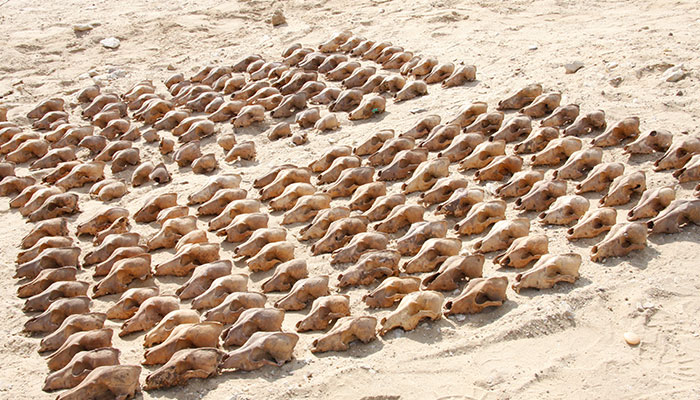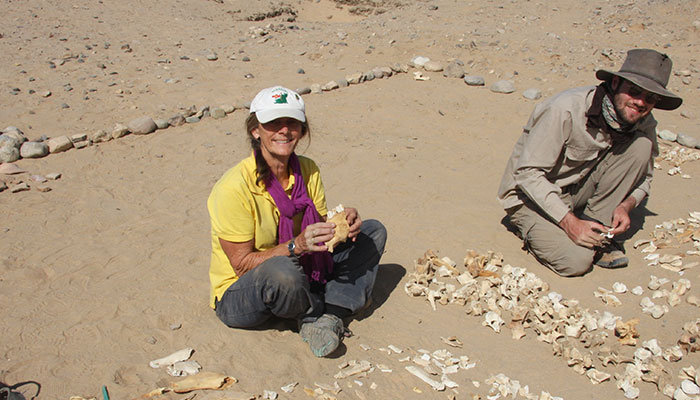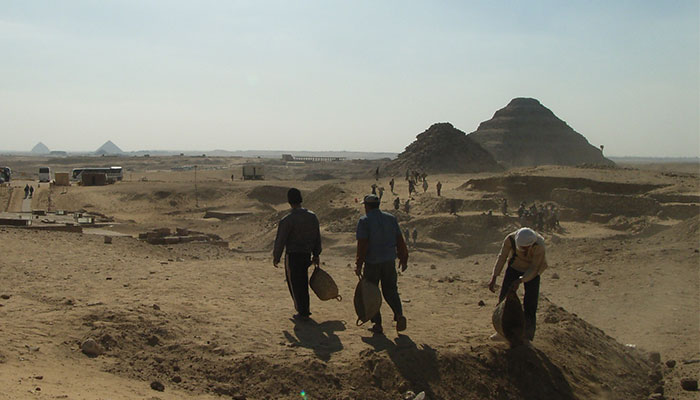Dr Mary Hartley, a researcher in Egyptology, has owned many dogs, the latest a black and white border collie. If they were all to follow her to the grave, her afterlife would be more crowded than an entombed warriors exhibition.

It is perhaps warm and fuzzy to imagine that the thousands of dog bones unearthed in the Teti Cemetery North at Saqqara, south of Cairo, during an excavation Dr Hartley was part of, were the bones of beloved pets buried with their masters. The reality is more prosaic.
Says Dr Hartley: "The afterlife was extremely important to the ancient Egyptians; it was a place full of potential dangers and worries but a place everyone aspired to."
The placement of dogs either at the foot of a coffin, at the entrance of tombs, or at the north, south, east and west boundary points of cemeteries, indicate, she says, a role more "protective" than "pet".
"To have a dog protecting you in the afterlife would have been highly desirable."
In a recent talk at the Queensland Museum Kurilpa, where the exhibition Discovering Ancient Egypt runs until August 17, Dr Hartley outlined the two very different uses of dogs in Ancient Egyptian funerary practice. One, from around 4000 BCE, was the actual burial of a dog either with a human or in a cemetery for humans. The other, from 644 BCE to the end of the Roman Period (30 BCE – AD 395) was the rise of the mummified votive dog.
"The first record of a dog buried with a human occurred around 4000 BCE and this funerary practice continued through to the end of the Roman Period," says Dr Hartley. "Around 3800 BCE, we also have records of dogs found buried at the boundaries of cemeteries and at the entrances to tombs."
Many of the dog burials were excavated 100 to 150 years ago and, says Dr Hartley, little attention was paid to them at that time. When analysis was undertaken on the skeletal remains, they frequently revealed a withers height of between 54cm to 57cm, indicating a long-legged dog like the greyhound, albeit with a tail that was short and curled up over the dog's back.
When the Late Period began around 644 BC, funerary practices previously available only to the elite could now be accessed by the entire population.
Beyond the Wonderwall
Saqqara is one of the richest archaeological sites in Egypt, one that Macquarie University has had a long association with. Between 2007 to 2010, an archaeological team led by Associate Professor Boyo Ockinga worked at the Teti Cemetery North at Saqqara.
During the team's excavations, bones of at least 1,314 canines were found across the site, most from three burial chambers relating to the New Kingdom (c.1570 BCE – c.1069 BCE). The dogs were discovered in 2007, when the excavations were just beginning.

Chamber of secrets: Dr Mary Hartley, pictured, sorting the team's discoveries at the dig in Saqqara, Egypt. Image: Mary Hartley.
Says Dr Hartley: "When the team opened the first burial chamber they were hit with a wall of skeletal remains and debris. There were hundreds of what appeared to be disarticulated dog bones mixed with pieces of cloth, wood, human remains and much dirt. The two other burial chambers revealed the same thing. It was overwhelming."
A macabre but significant discovery. "The sheer quantity of dog remains was important," says Dr Hartley. "We hoped we could find paleopathological evidence on the crania that would lead us to understand how the votive dogs were used in the funerary rituals of the people.
"The excavations were completed in 2010, by which time the team had sorted all the bones and chosen 119 of the crania to do the research into when, where, and why, and potentially how these dogs had been treated.
"We were then able to compare our analysis of the crania with another study undertaken on 400 dogs, part of seven million found in the dog catacombs nearby. There were similarities in our results that emphasised the way these dogs were used.
"Our dog skeletons were found disarticulated and unwrapped, so we could not determine how they were killed. However, many mummified dogs are found still in their original wrappings, meaning they are fully articulated. Occasionally these mummies are X-rayed and sometimes the X-rays reveal a gap between the second and third cervical vertebrae indicating that the dog had had its neck broken."
Morphological analysis on the 1,314 dogs found at Saqqara revealed that most were the common pariah dog, a mixed-breed, feral dog still found in Egypt today, living on the perimeters of villages and communities.
The artifacts of Anubis
The mass sacrifice of dogs in ancient Egypt can be sheeted home to Anubis, god of the necropolis, the afterlife, and embalming. Mummified votive dogs were sacrificed and offered to Anubis in the temples, most likely with a prayer and/or a request for his help in some matter.

The votive trade of dogs was controlled by the priests of the temples of Anubis. With the votive practice being made available to the entire population, the demand for dogs grew exponentially over a period of 1000 years.
"With the huge increase in demand, mummified dogs must have been specifically bred at a large scale and sacrificed regularly. Dog farms and breeding programs would have been implemented," Dr Hartley says.
"This became economically important to the temples, although the religious reason for the offerings would still have been the main reason behind the practice."
The Discovering Ancient Egypt Exhibition runs at the Queensland Museum in Brisbane until August 1
Dr Mary Hartley is a member of The Australian Centre for Egyptology in the Macquarie University School of Humanities.






